Showing Spotlights 1 - 8 of 48 in category All (newest first):
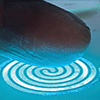 A new contactless user-interactive sensing display responds to finger movements and breath via humidity, enabling dynamic multicolor visuals for human-machine interactions.
A new contactless user-interactive sensing display responds to finger movements and breath via humidity, enabling dynamic multicolor visuals for human-machine interactions.
Apr 27th, 2024
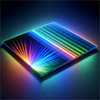 Recent breakthroughs integrate molybdenum disulfide transistor circuitry with large-area perovskite LEDs, promising unprecedented display quality with rapid response times and enhanced cost-efficiency.
Recent breakthroughs integrate molybdenum disulfide transistor circuitry with large-area perovskite LEDs, promising unprecedented display quality with rapid response times and enhanced cost-efficiency.
Dec 13th, 2023
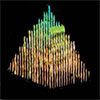 Researchers develop micro-amorphization technique that allows imprinting dynamic, full-color 3D voxel arrays throughout bulk transparent solids, enabling new horizons in data storage, quantum optics, and multidimensional information optics.
Researchers develop micro-amorphization technique that allows imprinting dynamic, full-color 3D voxel arrays throughout bulk transparent solids, enabling new horizons in data storage, quantum optics, and multidimensional information optics.
Oct 22nd, 2023
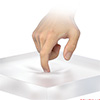 Inkjet printing techniques have yielded touchscreens that detect finger position and pressure in 3D. This breakthrough promises more intuitive interactions.
Inkjet printing techniques have yielded touchscreens that detect finger position and pressure in 3D. This breakthrough promises more intuitive interactions.
Oct 10th, 2023
 A recent review takes a look at the progress of organic field-effect transistors (OFETs) and their potential applications in flexible electronics. The authors explore the recent progress of OFET technology and some of the exciting, flexible electronic applications addressed by it.
A recent review takes a look at the progress of organic field-effect transistors (OFETs) and their potential applications in flexible electronics. The authors explore the recent progress of OFET technology and some of the exciting, flexible electronic applications addressed by it.
Mar 28th, 2023
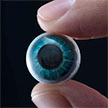 Ongoing smart contact lens research ranges from biosignal detection (intraocular pressure, glucose, cortisol) to therapeutic tools (aniridia, chronic ocular inflammation) and advanced features such as aumented reality displays and personalized designs using 3D-printing technology. Some of these technologies are already finding their way from the lab into commercial applications. The development of next-generation, smart contact lens technology is not just simply one field of bioelectronics but rather a complex, interdisciplinary effort that includes development of biocompatible materials; development of intuitive interfaces; and development of integration technologies capable of smart contact lens research.
Ongoing smart contact lens research ranges from biosignal detection (intraocular pressure, glucose, cortisol) to therapeutic tools (aniridia, chronic ocular inflammation) and advanced features such as aumented reality displays and personalized designs using 3D-printing technology. Some of these technologies are already finding their way from the lab into commercial applications. The development of next-generation, smart contact lens technology is not just simply one field of bioelectronics but rather a complex, interdisciplinary effort that includes development of biocompatible materials; development of intuitive interfaces; and development of integration technologies capable of smart contact lens research.
Apr 18th, 2022
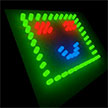 The three-dimensional (3D) geometry of 3D-printed nanopixels can increase the emission brightness of display pixels, varying with the height of the pixels, and can be used to fabricate super high-resolution devices. 3D printing of perovskite nanopillars can be used for creating nanoscale display pixels as well and the increase of the emission intensity can be saturated by the limited depth of field of the measuring optical system.
The three-dimensional (3D) geometry of 3D-printed nanopixels can increase the emission brightness of display pixels, varying with the height of the pixels, and can be used to fabricate super high-resolution devices. 3D printing of perovskite nanopillars can be used for creating nanoscale display pixels as well and the increase of the emission intensity can be saturated by the limited depth of field of the measuring optical system.
Jun 30th, 2021
 Liquid crystal materials are ubiquitous in everyday life. Recently, a new way to create advanced liquid crystal materials by merging nanotechnology and liquid crystals was discovered: by adding nanoscale objects to liquid crystals, new materials with superior physical properties can be created. However, this raises an important question: How do nanoparticles affect ionic processes in liquid crystals? Here is an overview of recent advances in the understanding of ionic phenomena in liquid crystals doped with nanomaterials.
Liquid crystal materials are ubiquitous in everyday life. Recently, a new way to create advanced liquid crystal materials by merging nanotechnology and liquid crystals was discovered: by adding nanoscale objects to liquid crystals, new materials with superior physical properties can be created. However, this raises an important question: How do nanoparticles affect ionic processes in liquid crystals? Here is an overview of recent advances in the understanding of ionic phenomena in liquid crystals doped with nanomaterials.
Mar 18th, 2021
 A new contactless user-interactive sensing display responds to finger movements and breath via humidity, enabling dynamic multicolor visuals for human-machine interactions.
A new contactless user-interactive sensing display responds to finger movements and breath via humidity, enabling dynamic multicolor visuals for human-machine interactions.
 Subscribe to our Nanotechnology Spotlight feed
Subscribe to our Nanotechnology Spotlight feed





